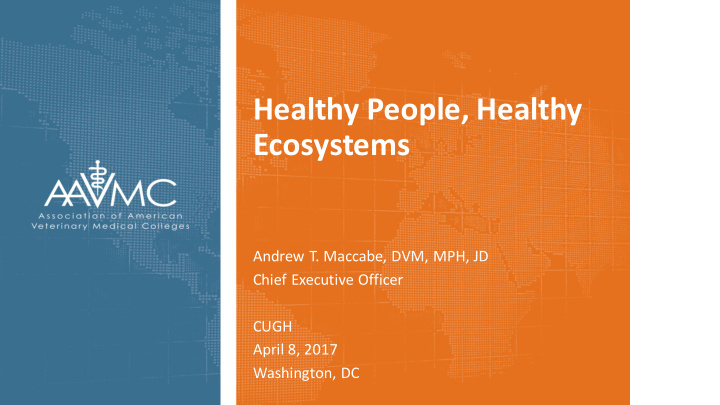



Healthy People, Healthy Ecosystems Andrew T. Maccabe, DVM, MPH, JD Chief Executive Officer CUGH April 8, 2017 Washington, DC
Healthy Animals, Healthy People, Healthy Ecosystems Andrew T. Maccabe, DVM, MPH, JD Chief Executive Officer CUGH April 8, 2017 Washington, DC
Healthy Animals Sustainable Food and Global production Healthy Nutritional of Animal Food animals Sourced Security Security Foods Food security , as defined by the USAID, means having, at all times, both physical and economic access to sufficient food to meet dietary needs for a productive and healthy life.
Healthy Animals Global Food Security Poverty Reduction Livestock health
Healthy Animals Global Food Security Poverty Reduction Increase productivity Income generation Improve animal Gain access to husbandry international markets Reduce endemic Eradicate transboundary animal diseases animal diseases Livestock health
Productivity potential % Lack of improved breed Morbidity and mortality due Losses due to poor Potential productivity Poor nutrition Realized productivity adoption to disease husbandry Animal Health and minimizing risk from disease related losses is essential to incentivize investment to improve genetic potential
Healthy People Most (75%) emerging diseases come from animals and cost up to US $ 6 billion annually
The W World H Health O Organization's g global t target f for r reducing c childhood s stunting b by 2 2025: r rationale a and proposed a actions Stunting among children under 5 Maternal & Child Nutrition pages 6-26, 18 SEP 2013 DOI: 10.1111/mcn.12075 http://onlinelibrary.wiley.com/doi/10.1111/mcn.12075/full#mcn12075-fig-0002
ANIMAL SOURCED PROTEIN:AN ESSENTIALPART OF THE SOLUTION Nutrient BestSource WhyASFsare unique VitaminA Dairy,eggs One eggyolkcan provide 1/3of a woman’srecommendeddailyintake Iron Meat (all) Meatscontainheme iron, whichfacilitatesthe absorptionof non-heme ironfromplantsources Zinc Meat (all) Zincfoundinmeatismore bioavailablethanfromplantsources Folate Eggs,poultrymeat Calcium Dairy Moderate levels of intakecanfullymeetthe recommendedcalciumrequirementsforchildrenandwomen Riboflavin Dairy,eggs VitaminB12 Meat,eggs,dairy ASFsare the onlyfood-basedsource. VitaminB12deficiencyresultsinpoorcognitive function,neural tube defects, and some typesof anemia. IGF-1 Diary Onlyfoundindairy,studiesshow thatinsulingrowthfactor1improve childgrowth Amino acid score Dairy,eggs, goatandpoultrymeat Exceeds100 (highquality)forall of these sources |
Healthy Environment • Animals and vegetation have co-evolved • Old grasslands depend on animal grazing • Extensive grazing is the only possibility to produce agricultural products • Pastoralism and agro-pastoralism are key production systems • 44% of global sheep, 29% of goats and 20% of cattle • Provide 22% of global beef production, and 16% of milk
Demand for livestock commodities in developing economies will be met – the question is how Scenario #1 Meeting livestock demand by importing livestock products Scenario #2 Meeting livestock demand by importing livestock industrial production know-how Scenario #3 Meeting livestock demand by transforming smallholder livestock systems
Smallholders: part of the solution • Not sentimentality or a belief in “small is beautiful” • Based on the evidence and the dual objectives of • increasing animal source food supply to consumers • supporting rural development and livelihoods • The evidence : • They produce the bulk of the livestock (and half of crop) products in developing countries so need to be part of increase supply strategy • They continue to be competitive so wont go away on their own • Does not detract from investing in larger commercial systems
• 70% of the world’s rural poor rely on livestock for important parts of their livelihoods • Of the more than 600 million poor livestock keepers in the world, around two-thirds are rural women • For the vulnerable, up to 40% of benefits from livestock keeping come from non- market, intangible benefits, mostly insurance and financing • In the poorest countries, livestock manure comprises over 70% of soil fertility amendments • 90% of animal products are produced and consumed in the same country or region
LIVESTOCK HEALTH AND FOOD SECURITY • The poor: with nearly 60% of population living with <$2 / day own livestock Who • Smallholders: the majority of livestock Livestock also has benefits? production comes from smallholders in both the potential to go SSA and SA beyond simply • Women : there are numerous livestock increasing income interventions and opportunities that benefit in helping smallholder women specifically (e.g., evening milk) farmers develop both • Income: an average 30% – 45% of annual financial security income comes from livestock, with a maximum of 70% from dairy farmers and food security How do they • Nutrition: livestock products provide micronutrients not found in other crops (e.g., zinc) benefit? that have been proven to improve school performance • Capital accumulation: given high contribution of livestock as an asset, it helps develop financial security |
Why Rabbits? • Rabbits reproduce frequently • Food for rabbits is widely available in the villages • There are no cultural taboos, age or gender-based responsibilities for raising or selling rabbits • Rabbits are easy for youth to raise while participating in school and family and community activities
• Loans in the form of a pig provide an opportunity to rebuild the rural economy in a way that is acceptable and familiar to villagers • Pigs consume a wide range of foods that are locally Pigs for Peace microfinance is available focused on reducing the negative health, economic and social needs • With the waste from the pigs, villagers can manage of rural families and communities their personal compost, which can be used to cultivate affected by poverty and conflict. their farms • Pigs reproduce frequently (two to three times per year) and generally produce 6-12 piglets at each breeding • Piglets are easy to sell on local markets for between $25-50 depending on their size and age allowing the member to have access to money that they can invest in their family
What’s the point?
• The problems of wild animals, domestic animals, humans and the environment are intertwined. • A holistic, integrated approach is required to solve complex problems. • Appropriate livestock interventions are an essential component of sustainable, small-scale agriculture and a critical component in rural economic development.
• Livestock projects are an effective tool to empower women and strengthen civil institutions • Creating economic opportunity and food security for the rural poor can reduce pressure on habitat and help protect endangered species
Recommend
More recommend